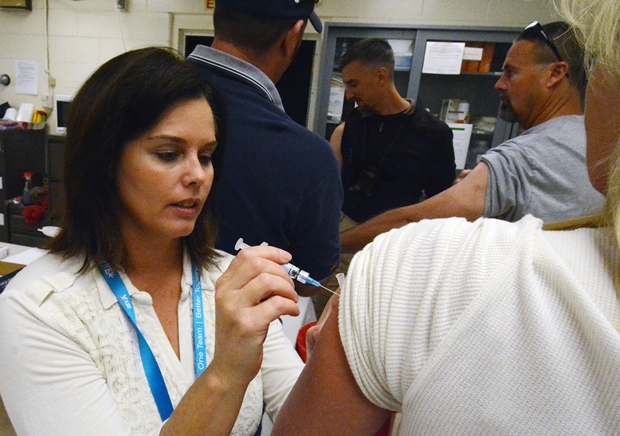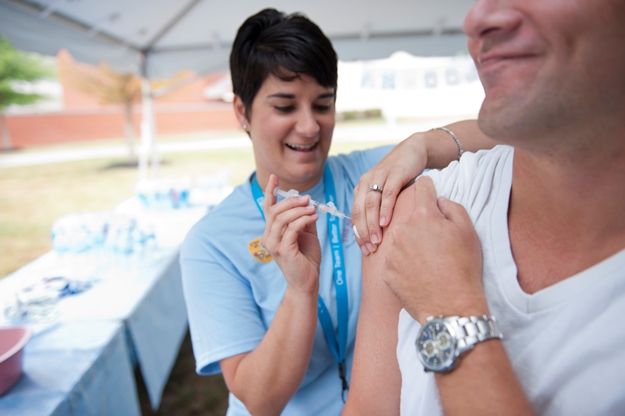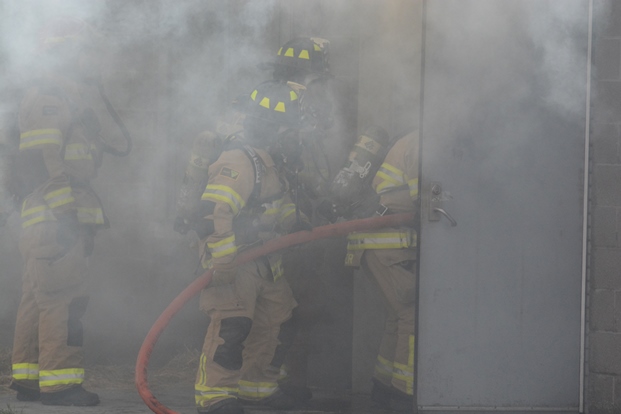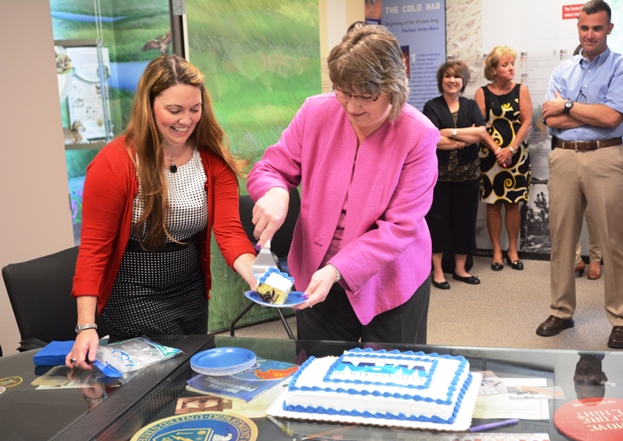Pantex Blog
Connecting with the Next Generation
Pantex employees supported the recent Top of Texas Career Expo for juniors and seniors across the Texas Panhandle. Professionals from various specialties, such as information technology, engineering, security and communications, shared job prospects, necessary education and skills, salary ranges and personal experiences. More than 800 students attended the event at West Texas A&M University.

Sean Usleton, systems architect, Amanda Helker, process engineer, and Kennith Springs, security police officer, talk to students about the variety of careers at Pantex.
Pantex, Y-12 prepare for flu season

Pantex nurse practitioner Tiffany Shadle administers a flu shot during opening day of the annual Flu Clinic.
Pantex and Y-12 employees have been taking advantage of free flu vaccine shots offered at each site in preparation for the upcoming winter months. The practice, which has been an ongoing service for decades at each site, is also good for the community because fewer residents are susceptible to the bug, which means they aren’t spreading it to coworkers, friends or family members.

Nurse Melissa Davis gives the flu vaccine to one of the more than 2,300 employees who took advantage of Y-12's "Flulapalooza."
Pantex Fire Department trains to ensure readiness, personnel safety

Knowing how to enter a burning building filled with smoke while battling a blaze requires continuous training to keep people safe. Pantex Fire Department’s recent training helped personnel stay familiar with their equipment and prepared for emergency situations they may not often see.
Bill Ho-Gland, Pantex Assistant Fire Chief, says the training helps support the site and the surrounding communities that may need Pantex assistance during an emergency. Pantex maintains Memorandums of Understanding with the counties surrounding the Pantex site and renders aid when requested.
Members of the Pantex Fire Department maintain certifications so they are ready to respond to any emergency that arises. This year’s training scenario involved an interior structure fire. The team had to bring the fire under control using effective water application practices, firefighting posture and attack techniques.
The Pantex Fire Department is certified through the Texas Commission on Fire Protection (TCFP) and regularly trains to ensure it meets or exceeds TCFP continuing education requirements. During recent emergency training, members of the department refreshed their training in the use of self-contained breathing apparatus and other personal protective equipment.
Pantexans Dish Up Barbecue
Pantex is a longtime supporter of the Amarillo Chamber of Commerce event

More than a dozen Pantexans volunteered to help cook and serve some delicious barbecue Wednesday night at the annual Amarillo Chamber of Commerce Good Times Celebration and Barbecue Cookoff. For more than a decade, Pantex has been a prominent supporter of the event, which is the Chamber's largest fundraising event of the year.

Pantex Takes On Weather Preparedness
Plant first DOE entity named Storm-Ready Nation Ambassador

National Weather Service Warning Coordination Meteorologist Krissy Scotten, from left, presented the WRN Ambassador designation to Pantex Site Manager Michelle Reichert and Carson County Emergency Management Coordinator Brenda Vermillion at a Pantex ceremony Tuesday.
Officials from the National Oceanic and Atmospheric Administration named Pantex Plant a Weather-Ready Nation (WRN) Ambassador Tuesday. The WRN program is a new initiative to spread critical information to residents about how to prepare for and respond to a weather emergency. Ambassadors take the lead in helping unify efforts across government, non-profits, academia and private industry to make the nation more ready, responsive and resilient against severe weather.
Pantex joined Carson County this month as a WRN Ambassador, with plans for multiple events throughout September to spread the message about weather preparedness to Pantexans and county residents. Pantex is the first DOE entity named a WRN Ambassador, and Carson County is the first county in the Texas Panhandle to achieve the designation.

